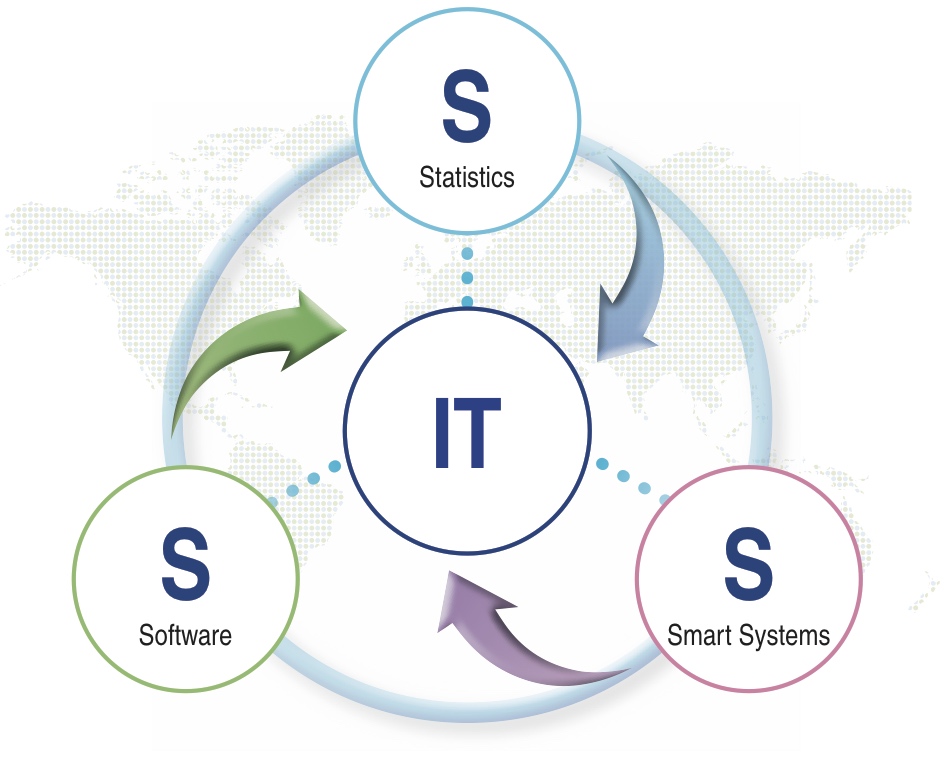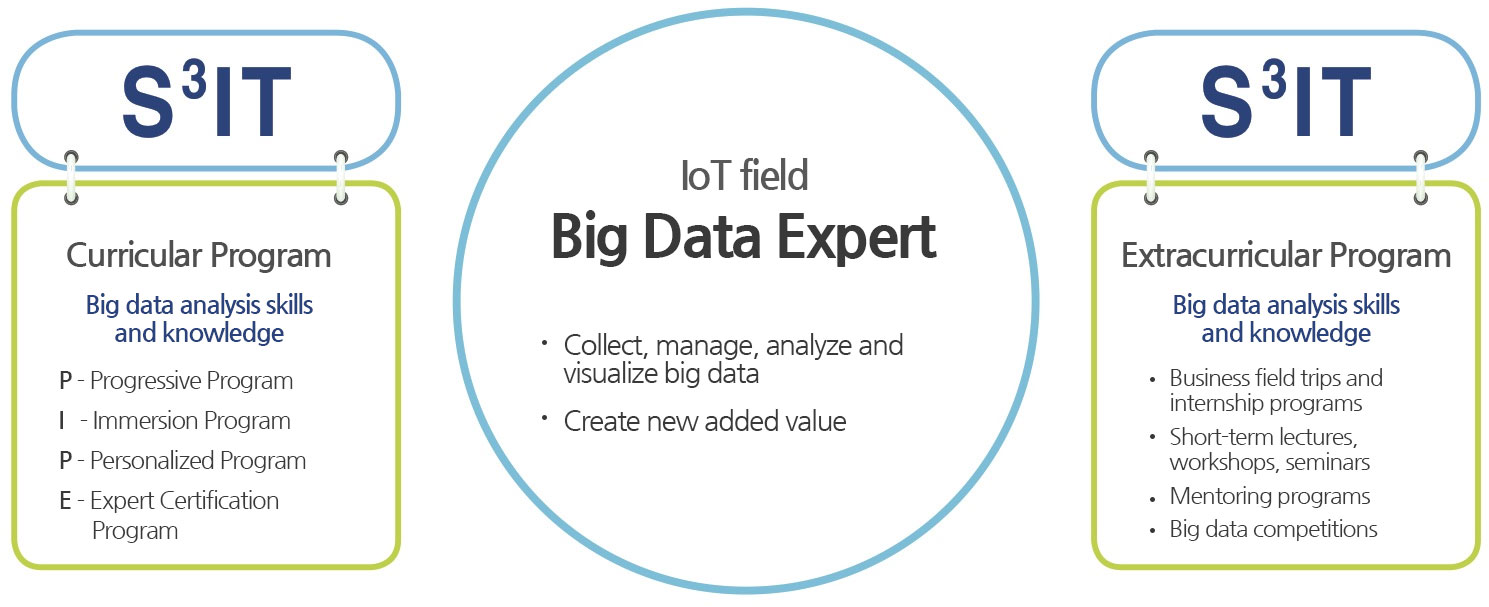S3IT convergence major program for nurturing big data experts
1. The need for big data convergence education
| The advent of the Internet of Things (IoT) era |
|---|
|
The advent of the Internet of Things (IoT) era
ㆍ About 60 billion thins expected to be connected to the Internet by 2020 (Cisco) |
2. What is the S3IT Convergence Major Program?

This refers to Korea's first big data undergraduate convergence major program, which is jointly provided by the Department of Statistics and Actuarial Science, the Department of Software, and the Department of Smart Systems Software, to foster big data experts.
3. Goal and composition of S3IT Convergence Major Program

| The purpose of the S3IT convergence major program is to foster bid data experts who will lead the big data industry |
|---|
| ㆍ Cultivate expertise in big data collection, management, analysis, and visualization ㆍ Cultivate the ability to create new added value |
| Composition of S3IT Convergence Major Program |
|
ㆍ Curricular Program ㆍ Extracurricular Program |
4. S3 Convergence Major Extracurricular Program
ㆍ Support for company tours and internship programs |
S3IT Convergence Major to Cultivate Big Data Analysis Experts
1. The purpose of S3IT Convergence Major is to provide the skills and knowledge necessary for big data analysis.
2. The entire curriculum consists of five required subjects and 24 elective subjects.성
3. A total of 36 credits (12 courses) must be taken - 21 credits can be recognized as overlapping major courses in the department.
4. The required subjects of the big data convergence major - All five subjects must be taken.
| Statistics and Actuarial Science | Software | Smart System Software | |
|---|---|---|---|
| 3-2 | Ubiquitous Sensor Network | ||
| 4-1 | Deep Learning Analysis | Big Data Analysis | |
| 4-2 | Big Data Distributed Computing | Information Search and Web |
5. The elective subjects of the big data convergence major - All seven subjects must be taken.
| Statistics and Actuarial Science | Software | AI Convergence | |
|---|---|---|---|
| 2-1 | Regression Analysis 1 Basic Deep Learning |
Data Structure | Data Structure |
| 2-2 | Computational Statistics1 | Algorithm | Mobile Programming Algorithm Probability and Statistics |
| 3-1 | Computational Statistics2 | Database Artificial Intelligence Software Engineering |
Operating System Sensor Motion Robotics Software Engineering |
| 3-2 | Multivariate Analysis Simulation |
Data Science Database Application Operating System |
IoT Programming |
| 4-1 | Categorical Data Analysis | ||
| 4-2 | Data Mining |
6. Introduction of Required Subjects
| Big Data Distributed Computing | Students acquire basic knowledge (MapReduce) necessary to analyze big data using Hadoop in the "R" environment. They also learn examples such as Hadoop Distributed File System (HDFS) and HBase NoSQL database to apply them practically to the data. |
|---|---|
| Deep Learning Analysis | Students study the basic concepts of data visualization using the ‘TongGrami’ software. Students research how to use various packages of “R” for big data visualization. Students study how to use the D3.js JavaScript library to realize big data visualization on the web. |
| Big Data Analysis | Social network service data is big data that is significant in the Internet society. This subject provides technical techniques for researching and analyzing existing various types of social media service attributes and collections. Students examine basic knowledge of social media services and perform big data analysis using actual social media service data. They also learn big data analysis cases. |
| Information Search and Web | The standardized data processed based on the relational database system must exist within a schema that is standardized and difficult to change. The modern information society, in which the demand for big data analysis and processing is increasing, requires processing, management, and analysis of unstructured data as well as structured data. In particular, technical requirements for unstructured data are continuously increasing, especially with the recent NoSQL technology trend. In this subject, students examine text and XML data processing techniques, which are representative forms of unstructured data, and look into the web database field where two types of unstructured data are most commonly present. |
| Ubiquitous Sensor Network | The ubiquitous environment configures a network of various sensing devices such as mobile devices, smart devices, and embedded sensor systems to transmit physical environment information and personalization information to the cloud server. The server may perform cloud computing based on a large amount of data to instruct these devices to take appropriate software actions. In this class, students define all these processes as a ubiquitous sensor network, and learn related element technologies and issues. |
| Big Data Distributed Computing |
|---|
| Students acquire basic knowledge (MapReduce) necessary to analyze big data using Hadoop in the "R" environment. They also learn examples such as Hadoop Distributed File System (HDFS) and HBase NoSQL database to apply them practically to the data. |
| Deep Learning Analysis |
| Students study the basic concepts of data visualization using the ‘TongGrami’ software. Students research how to use various packages of “R” for big data visualization. Students study how to use the D3.js JavaScript library to realize big data visualization on the web. |
| Big Data Analysis |
| Social network service data is big data that is significant in the Internet society. This subject provides technical techniques for researching and analyzing existing various types of social media service attributes and collections. Students examine basic knowledge of social media services and perform big data analysis using actual social media service data. They also learn big data analysis cases. |
| Information Search and Web |
| The standardized data processed based on the relational database system must exist within a schema that is standardized and difficult to change. The modern information society, in which the demand for big data analysis and processing is increasing, requires processing, management, and analysis of unstructured data as well as structured data. In particular, technical requirements for unstructured data are continuously increasing, especially with the recent NoSQL technology trend. In this subject, students examine text and XML data processing techniques, which are representative forms of unstructured data, and look into the web database field where two types of unstructured data are most commonly present. |
| Ubiquitous Sensor Network |
| The ubiquitous environment configures a network of various sensing devices such as mobile devices, smart devices, and embedded sensor systems to transmit physical environment information and personalization information to the cloud server. The server may perform cloud computing based on a large amount of data to instruct these devices to take appropriate software actions. In this class, students define all these processes as a ubiquitous sensor network, and learn related element technologies and issues. |